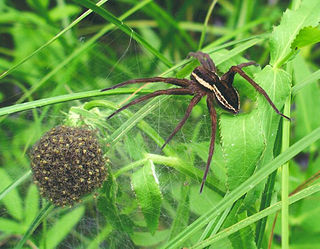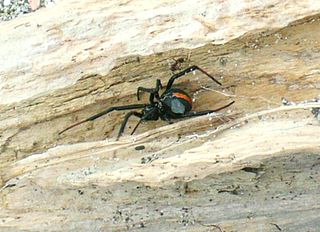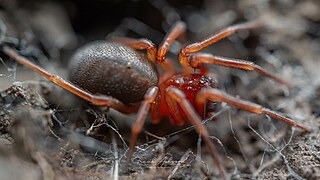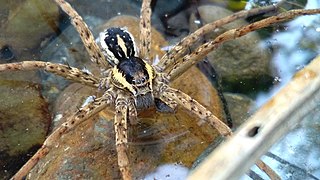
Dolomedes is a genus of large spiders of the family Dolomedidae. They are also known as fishing spiders, raft spiders, dock spiders or wharf spiders. Almost all Dolomedes species are semiaquatic, with the exception of the tree-dwelling D. albineus of the southeastern United States. Many species have a striking pale stripe down each side of the body.

Dolomedes minor is a spider in the family Dolomedidae that is endemic to New Zealand, where it is known as the nursery web spider.

Dolomedes aquaticus is a species of fishing spider that lives and hunts along the gravel banks of unforested New Zealand rivers. It prefer open riverbanks where it typically lives under rocks, usually less than 5 metres away from the river. Its colouring allows it to camouflage against river stones. Normally nocturnal, it will sit and wait for prey after dark, and can survive for short periods under the water.

New Zealand has 1157 described spider species, with an estimated total fauna of 2000 species. Over 97 per cent are endemic, and the rest have been introduced through human activities or were natural wind-borne introductions.

Hadramphus spinipennis, commonly called the coxella weevil, is a large, nocturnal, flightless weevil only found on Mangere and Rangatira Islands in the Chatham Islands, New Zealand.

Pacificana is a genus of spiders in the family Miturgidae. It was first described in 1904 by Hogg. As of 2017, it contains only one species, Pacificana cockayni, found in New Zealand.

Periegops suterii is a species of spider in the genus Periegops that is endemic to the South Island of New Zealand.

Anoteropsis litoralis is a species of wolf spider that is endemic to New Zealand.
Creophilus rekohuensis is a beetle of the Staphylinidae family, subfamily Staphylininae. This species occurs only on some small predator-free islands in the Chatham Islands, New Zealand, where it lives in seabird burrows. Its name derives from Rekohu, the Moriori name for Chatham Island.

Dolomedes dondalei is a species of large fishing spider endemic to the main islands of New Zealand. It is a nocturnal hunter, feeling the water surface for vibrations, and catches insects and even small fishes – the only New Zealand Dolomedes species able to do so.

Dolomedes facetus, commonly known as the clever fishing spider, is a species of medium to large-sized fishing spider endemic to Australia. It lives in freshwater ponds and waterways in coastal areas, ranging from Western Australia to Tasmania. It is common in northern parts of Australia, particularly Queensland and the Northern Territory. It has also been introduced and become naturalised to New Zealand.

Sidymella angularis, is a species of crab spider endemic to New Zealand.
Waiporia chathamensis is a species of Orsolobidae that is endemic to New Zealand.
Whakamoke rakiura is a species of Malkaridae that is endemic to New Zealand.
Cryptaranea venustula is a species of orb-weaver spider that is endemic to New Zealand.
Haplinis tegulata is a species of sheet weaver spider endemic to New Zealand.
Pseudafroneta frigida is a species of sheet weaver spider endemic to New Zealand.

Phycosoma oecobioides is a species of cobweb spider that is endemic to New Zealand.
Anoteropsis alpina is a species of Lycosidae that is endemic to New Zealand.

Anoteropsis insularis is a species of Lycosidae spider that is endemic to New Zealand.















